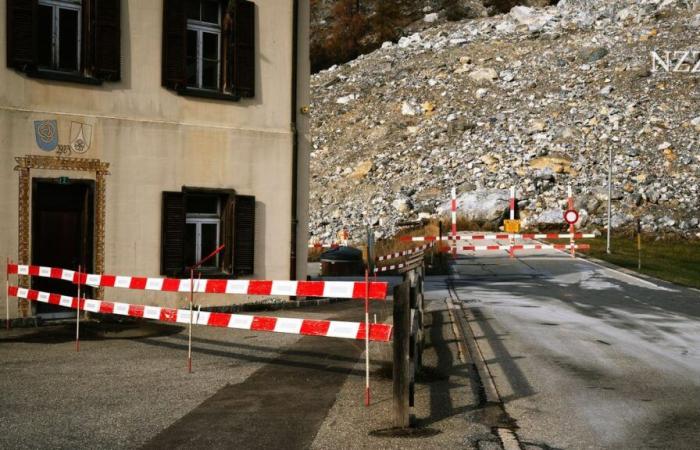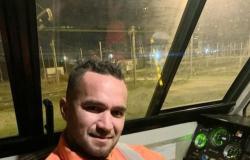It would be a national precedent: an entire town has never been relocated because of a natural hazard. The authorities in the Albula Valley suggest three possible locations. But the people of Brienz fear being torn apart.
The residents of Brienz had to leave their village for the second time.
Karin Hofer / NZZ
It is late afternoon and the sun is still barely shining on Brienz when a semi-trailer truck drives down the narrow road into the valley. It is loaded with bales of hay. The farmers bring their winter supplies to safety. Because their home has become a restricted zone. Again.
The Graubünden mountain village is being evacuated for the second time. 80 people have to leave their homes; they have until Sunday, 1 p.m. They are fleeing from a million cubic meters of rubble that threatens to thunder into the village. The mountain has been slipping here for decades. And so the people of Brienz take what they can with them: clothes, photo albums, ID cards. And the farmers the hay.
Most people still expect to be able to return. But no one knows when that will be. At an information event last week it was said that it could take months until the rubble pile stabilizes. It depends on how much it rains. How quickly the snow melts in spring. Whether there are rock falls that could cause the heap to slide. For now all that remains is to hope, fear, pray.
But what if the village becomes uninhabitable forever? What if the rubble comes loose and destroys everything? Or if the risk of returning remains too high? In this case, the authorities are working on a relocation scenario. This means that the entire village would be rebuilt elsewhere; 13 single-family houses and 37 apartments are potentially affected. It would be the largest resettlement that has ever taken place in Switzerland.
From the sun terrace to the shadow valley?
Alvaneu is a twenty-minute drive from Brienz in the direction of Davos. Two people get out of the post bus, which stops directly at Volg. Like Brienz, Alvaneu is located on the steep southern slope of the Albula Valley, the houses are arranged in terraces, there is a baroque church and an entry in the federal inventory for sites worthy of protection. This is one of three places that are eligible for resettlement.
But the plot of land on which the new Brienz could one day be built is not on the sunny slope of Alvaneu, but below the main road, next to the retirement home. A small forest casts its shadow on the meadow, so that the snow from last night remains there. There are two football goals without a net, a fireplace and a playground.
Is the new Brienz being created here? And how is that even supposed to work – moving an entire village to another?
The canton and the municipality of Albula, to which Brienz belongs, have been looking for places for resettlement for four years. But building land is rare, it would require rezoning and a change to the cantonal structure plan. Ownership relationships must be clarified, the townscape and landscape must be taken into account and conflicts with agricultural businesses must be avoided. An almost impossible task.
A second possible location is in Tiefencastel, the main town of the municipality of Albula. Tiefencastel is 250 meters lower than Brienz, on the Rhaetian Railway line. The plot in question is located in a curve on the main road towards Julier Pass, a popular route for motorbike rides. It is said that Tiefencastel is shady for six weeks in winter.
There will no longer be a separate church
Many people from Brienz react cautiously to the proposed locations. You have a lot to lose up there: sun, views, peace and quiet. “The proposed locations are no comparison to the situation in Brienz,” says a resident who did not want to be named. And: “We have lived here for decades and are a community.”
The Brienz case shows that relocating a village is about more than just new apartments and houses. It’s about identity. And about the solidarity that arises in the streets where people greet each other, in the church where they sing, on the village square where they meet. “We are afraid of being torn apart,” says the resident.
The situation on the mountain above Brienz has become worse: 80 people have to be evacuated.
Karin Hofer / NZZ
Daniel Albertin is mayor of Albula. He is a member of a commission set up specifically for resettlement and says we have to be realistic. “There will not be a second Brienz with its own village square and church. That would be nice, but we simply don’t have the space for it.”
The historic mountain village would become a densely built new district. This is shown by the few sketches that exist of the potential settlements. A report states that everyone from Brienz is free to look for a new home themselves. The resettlement is just an offer.
But who will be able to do without this offer in a canton where free apartments will soon be as scarce as in Zurich?
The hope lies in Vazerol
Recently there has been some hope again, it lies in a small settlement called Vazerol. This is the third possible location for the resettlement. Vazerol was a district of Brienz when the village was still an independent political community. It would be a move within a familiar radius.
Mike Casutt lives here. He runs an architectural office and built a holiday home in Vazerol a few years ago. He liked the location so much that he built his own house next door. Red and white barrier tape flutters ten meters behind his kitchen window. The exclusion zone, in which Brienz is also located, begins here.
For a long time, Vazerol was considered too unsafe. But in September of this year the situation was reassessed and part of Vazerol was removed from the danger zone. This is now being discussed as a location. According to a survey, the majority of Brienz residents would prefer to move here.
Casutt wouldn’t mind having new neighbors. He thinks it’s good that the community is pushing ahead with plans for relocation. He just fears that the interests of second home owners in Brienz will be neglected. “About a third of Brienz is made up of second-time residents,” he says. “Many are loyal holiday guests; they have been part of village life for a long time.”
In fact, the focus so far has been on the locals. The matter seems complicated enough. How much money would the residents of Brienz be compensated if they had to leave their house forever? Who would pay? And would that be enough to build a new house at one of the locations?
Land assets are not insured
Many of these questions are open because there are hardly any comparable cases. In Mitholz in the Bernese Oberland an entire village has to move, but there it is clear who is to blame. The army once stored tons of explosives in Mitholz. That’s why it’s the federal government that now has to buy the locals’ houses.
Even when the Grisons village of Marmorera was flooded in the 1950s, it was clear who would pay. The Zurich Electricity Works built a dam there and compensated the villagers for their lost property. But who is to blame when a mountain slides?
A comparable case to Brienz can be found in Schwanden, in the canton of Glarus. Part of the village there was destroyed by a mudslide in 2023. Building insurance paid the owners as much as the house was worth at the time of destruction.
But so far not a single house has been destroyed in Brienz. The village would first have to be declared a permanent exclusion zone before the insurance companies would pay. And there is a second problem: only houses are protected by the insurance, not land assets. Many landowners could hardly buy a piece of land elsewhere.
“Giving up means giving up”
Losing your home – and not knowing what will happen next financially. The fate of the Brienz people is of national importance. Because if the village is to be relocated one day, in the future it will be based on how much money was paid for it.
At the moment Brienz is still an isolated case. But because of climate change, natural disasters are becoming more common. If you are too generous, if you make too many spatial planning exceptions, the next village affected will have the same demands.
Next week, the municipality of Albula will provide information about the relocation at an event. Mayor Daniel Albertin still hopes that the plans will never have to be put into action. “We have to be aware,” says Albertin: “Giving up means giving up. Then there will be no more Brienz.”
An article from the «»






